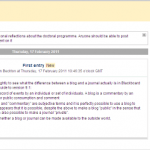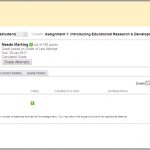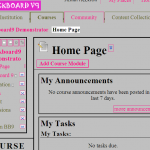I’ve just been reading a very interesting article by Alan Amory. ((Amory, 2010) Education Technology and Hidden Ideological Contradictions. Educational Technology & Society, 13 (1) 69-79 for those of you who like references.) His argument is that educational technology, as we use it in higher education is driven by a distinctively neo-liberal mindset that reinforces the status quo, rather then doing anything to promote radical change, or indeed doing very much to promote learning. While acknowledging that learning technologies need not be used this way, he describes reusable learning objects as being based on “totalitarian ideologies of instruction”. I think what he means by this is that they present learning as a sort of “jigsaw” that can be assembled into a picture, which itself has been defined by the status quo. In other words they don’t easily allow for re-interpretation into a new picture. He describes learning management systems (like Blackboard) as “observation and control systems” and blended learning as “perpetuating the past” by simply bringing technologies into existing courses without making any pedagogical change. On the whole, I’m inclined to agree, although I’m not sure I blame the technologies for the way they’re being used.
To steal his rather nice phrase, it promotes learning from technology, rather than learning with technology. He goes on to argue for a much more social approach to learning – that we should see technologies as tools rather than objects, and use them to encourage students to work collaboratively to produce new learning, which of course sits quite comfortably with the Student as Producer project here at Lincoln. We certainly don’t want to see students as consumers of a rather ill-defined “educational product” that they pay £9000 (or whatever) for? I’m not going to get into the question of exactly what the cost of a degree covers, since I can’t see that you can buy something that you do yourself, such as learning. But Amory’s argument suggests that universities should principally be providing a space where people can learn socially, a space which may or may not be digital, although these days I would expect it to have quite a significant digital component.
The problem is of course that LMS’s aren’t often used to support social learning. Many would say, rightly, that they’re not designed to, but most of them do have some features which could be used to encourage it. Blackboard has wiki tools, and discussion groups for example, but these are still usually tutor led. Amory suggests creating learning spaces in virtual worlds, where students and tutors can work together to identify and resolve problems related to the discipline, I can see how that might work in theory, although I haven’t seen any virtual world software that is nearly accessible (or robust) enough to be deployed on an institutional scale, (although I suppose they don’t need to be 3D worlds like Second Life – they could just as well be text based). The theory is, and I admit to over-simplifying here, that students and tutors form social networks, based on a shared interest in the subject. The members of the network then work together to identify and resolve problems of importance to the discipline. Which is all very well, but it doesn’t get us away from education as a commodity. Marks are a commodity which are exchanged for another, academic work. How do we measure individual student’s contributions for assessment purposes in this kind of learning? Does it matter? More to the point of this post, how can we get the kind of social networking Amory describes inside an LMS or VLE?




You must be logged in to post a comment.